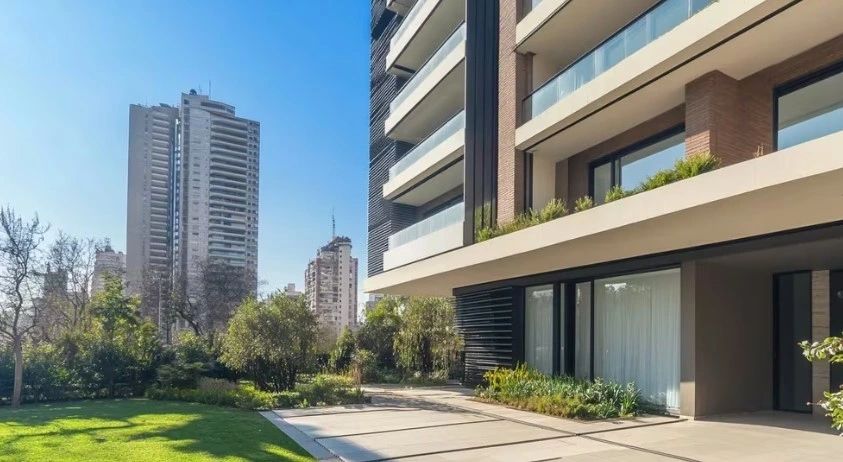BuySellBA
Administrator
$59 billion in mortgage loans were granted in August: what types of homes were sold - Infobae

Source:

 www.infobae.com
www.infobae.com
September 16, 2024
This was confirmed by a private analysis based on data from the Central Bank. Are we facing a new credit boom in CABA?
By Jose Luis Cieri

In most banks that already grant UVA-adjusted mortgage loans, the operation is carried out completely digitally.
Since April, mortgage loan applications and amounts in Argentina have registered a considerable increase. A private analysis recorded that there was an acceleration and in the city of Buenos Aires $59 billion in mortgage loans were disbursed to individuals, equivalent to 515 loans for one-bedroom apartments of 50 square meters.
It is worth remembering that it was the Mortgage Bank that first reintroduced them with new lines adjusted by the Purchasing Value Unit (UVA), for up to $250 million over thirty years.
Today, more than 20 banks offer them and according to a report by the Tejido Urbano Foundation together with the economist from the Empiria consultancy and expert in the sector, Federico González Rouco , the resurgence of mortgage loans has been evident since April.
That month, the available credit allowed the financing of the acquisition of 33 apartments. In May, the figure rose to 44, in June to 72, in July to 190 and in August the number of loans exceeded 500.
"Although these levels are still low compared to the potential demand in the country, the growth is significant considering the starting point. And it is estimated that the number of loans will increase in the immediate future," González Rouco told Infobae .
During those months, credit was barely enough to finance 20 apartments per month, according to the average values published by Zonaprop. However, starting in April, when three banks reopened their credit programs, the market began to become more dynamic.
Fernando Álvarez de Celis , executive director of the Tejido Urbano foundation, said that “in October, credit reached 194 apartments and in November 201. On average, between January and September 2023, the volume of credit reached 94 monthly credits, which then doubled in the October-November period.”
2020-2023 will likely be the presidential term with the lowest amount of credit granted, at least since records began. “Beyond 2020, when the pandemic could have had an impact, in 2022 less credit was granted (in terms of GDP) than in 2002, for example,” added Álvarez de Celis.
This last period benefited significantly from the implementation of UVA, which will not be replicated today. Thus, any future improvement will depend on a sustained increase in the purchasing power of wages.

The impact of the relaunching of credit lines meant that in just 60 days, some 20 banks began to offer mortgage products (between the end of April and last June) (Illustrative Image Infobae)
The impact of housing policies and macroeconomic regulation on the credit market is clearly reflected in the data. “The 2016-2018 period saw an expansion in the origination of mortgage loans, with financial institutions such as Banco Nación playing key roles. This dynamism allowed peaks of up to 4,500 loans per month to be reached during those years. However, the 2018 currency crisis negatively affected this growth, rapidly reducing the volume of loans issued,” recalled Álvarez de Celis.
The reduction in credit in terms of Gross Domestic Product (GDP) during recent governments, combined with the 2020 Rental Law (already repealed by the current Government through a DNU), widened the housing crisis that persists in Argentina.
However, at that time, the initial credit volume was higher, equivalent to 280 apartments per month between January and April 2016. This volume began to grow with the introduction of UVA loans and Banco Nación's “Nación Tu Casa” loans. By July 2016, the volume already covered 385 50-square-meter apartments, and by the end of that year, up to 1,000 apartments were financed per month.
Álvarez de Celis said: “As for the future of mortgage lending in Argentina, the outlook is cautiously optimistic. The recent growth in the volume of loans, driven by greater supply, shows that demand has always been there.”
However, the process of new credits is likely to reach a ceiling more quickly than in the 2016-2018 period, due to the fact that current incomes have less purchasing power.
Although credit may settle at levels higher than those of the 2020-2023 period, it will remain below the 2016-2017 peak until there is sustained wage growth. Therefore, any improvement in access to housing and in the revitalization of the real estate market will have to depend on an improvement in the purchasing power of income, the study reported.
“However, recent growth is a promising sign both for housing access and for the real estate market in general,” concluded González Rouco.
www.buysellba.com

Source:

En agosto se otorgaron $59.000 millones en créditos hipotecarios: qué tipos de viviendas se vendieron
Así lo confirmó un análisis privado basado en datos del Banco Central. ¿Se está frente a un nuevo boom de créditos en CABA?
September 16, 2024
This was confirmed by a private analysis based on data from the Central Bank. Are we facing a new credit boom in CABA?
By Jose Luis Cieri

In most banks that already grant UVA-adjusted mortgage loans, the operation is carried out completely digitally.
Since April, mortgage loan applications and amounts in Argentina have registered a considerable increase. A private analysis recorded that there was an acceleration and in the city of Buenos Aires $59 billion in mortgage loans were disbursed to individuals, equivalent to 515 loans for one-bedroom apartments of 50 square meters.
It is worth remembering that it was the Mortgage Bank that first reintroduced them with new lines adjusted by the Purchasing Value Unit (UVA), for up to $250 million over thirty years.
Today, more than 20 banks offer them and according to a report by the Tejido Urbano Foundation together with the economist from the Empiria consultancy and expert in the sector, Federico González Rouco , the resurgence of mortgage loans has been evident since April.
That month, the available credit allowed the financing of the acquisition of 33 apartments. In May, the figure rose to 44, in June to 72, in July to 190 and in August the number of loans exceeded 500.
"Although these levels are still low compared to the potential demand in the country, the growth is significant considering the starting point. And it is estimated that the number of loans will increase in the immediate future," González Rouco told Infobae .
From the starting point
The comparison, according to the analysis, highlights that the period from December 2023 to March 2024 was one of the worst in terms of the generation of new mortgage loans, considering only the pandemic crisis as the worst precedent.During those months, credit was barely enough to finance 20 apartments per month, according to the average values published by Zonaprop. However, starting in April, when three banks reopened their credit programs, the market began to become more dynamic.
The real estate market maintains that the largest number of mortgage loan transactions were for the purchase of one-bedroom apartments in CABA
Fernando Álvarez de Celis , executive director of the Tejido Urbano foundation, said that “in October, credit reached 194 apartments and in November 201. On average, between January and September 2023, the volume of credit reached 94 monthly credits, which then doubled in the October-November period.”
2020-2023 will likely be the presidential term with the lowest amount of credit granted, at least since records began. “Beyond 2020, when the pandemic could have had an impact, in 2022 less credit was granted (in terms of GDP) than in 2002, for example,” added Álvarez de Celis.
Second semester
Analyzing the scenario for the second half of 2024, the Central Bank reported that the acceleration in the appearance of credits could stabilize at levels higher than those of the 2020-2023 period, but below the peak of 2016-2017.This last period benefited significantly from the implementation of UVA, which will not be replicated today. Thus, any future improvement will depend on a sustained increase in the purchasing power of wages.

The impact of the relaunching of credit lines meant that in just 60 days, some 20 banks began to offer mortgage products (between the end of April and last June) (Illustrative Image Infobae)
The impact of housing policies and macroeconomic regulation on the credit market is clearly reflected in the data. “The 2016-2018 period saw an expansion in the origination of mortgage loans, with financial institutions such as Banco Nación playing key roles. This dynamism allowed peaks of up to 4,500 loans per month to be reached during those years. However, the 2018 currency crisis negatively affected this growth, rapidly reducing the volume of loans issued,” recalled Álvarez de Celis.
The reduction in credit in terms of Gross Domestic Product (GDP) during recent governments, combined with the 2020 Rental Law (already repealed by the current Government through a DNU), widened the housing crisis that persists in Argentina.
Two scenarios
There are some differences between the current start of the mortgage credit market and that of 2016. In December 2015, when Cambiemos assumed the presidency, the starting point was similar from a macroeconomic perspective.However, at that time, the initial credit volume was higher, equivalent to 280 apartments per month between January and April 2016. This volume began to grow with the introduction of UVA loans and Banco Nación's “Nación Tu Casa” loans. By July 2016, the volume already covered 385 50-square-meter apartments, and by the end of that year, up to 1,000 apartments were financed per month.
Álvarez de Celis said: “As for the future of mortgage lending in Argentina, the outlook is cautiously optimistic. The recent growth in the volume of loans, driven by greater supply, shows that demand has always been there.”
However, the process of new credits is likely to reach a ceiling more quickly than in the 2016-2018 period, due to the fact that current incomes have less purchasing power.
Although credit may settle at levels higher than those of the 2020-2023 period, it will remain below the 2016-2017 peak until there is sustained wage growth. Therefore, any improvement in access to housing and in the revitalization of the real estate market will have to depend on an improvement in the purchasing power of income, the study reported.
“However, recent growth is a promising sign both for housing access and for the real estate market in general,” concluded González Rouco.
www.buysellba.com

